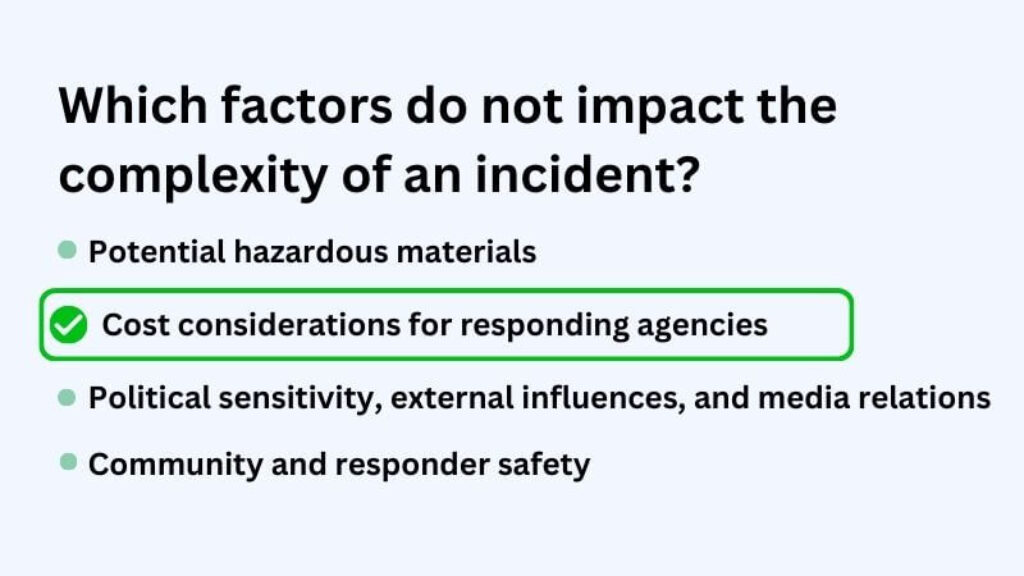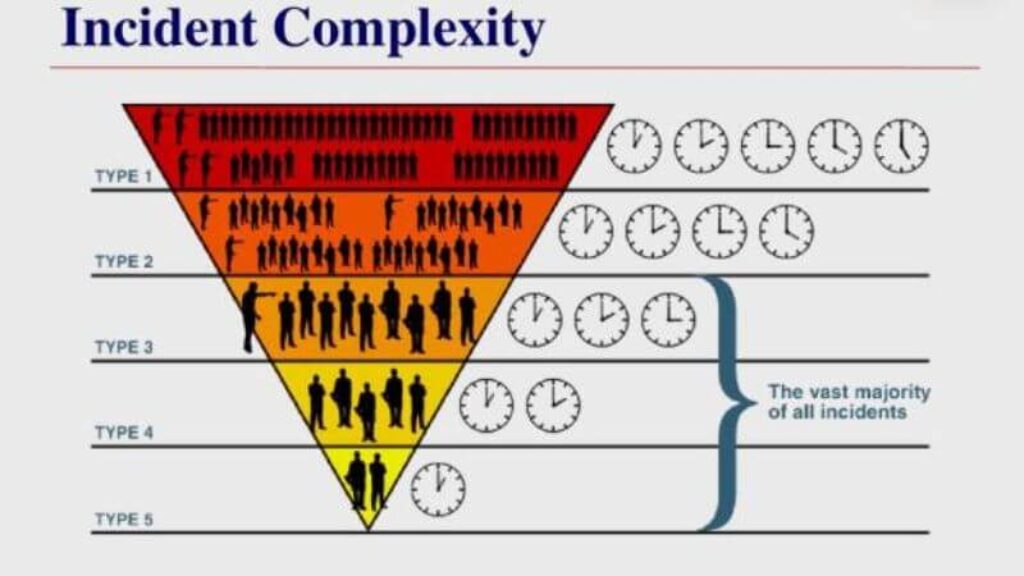Before we discuss the factors that don’t change the complexity of an incident in detail, first answer the following question:
Which of the following factors does not impact the complexity of an incident?
- Potential hazardous materials
- Cost considerations for responding agencies
- Political sensitivity, external influences, and media relations
- Community and responder safety
The right answer is: B. Cost considerations of responding agencies
Confused? Let us explain this to you.

Answer Explanation
Potential hazardous materials
The presence of any kind of hazardous material involved in an incident adds extra complexity to the present situation. These materials are toxic, explosive, poisonous, and liable and can cause serious threats to human lives (both in terms of physical injuries and even fatalities), nature, and infrastructure.
They demand skilled professionals and equipment who know the protocols and can safely handle, contain, dispose of them and reduce the risks.
Any carelessness could lead to severe damage and, hence, potentially hazardous materials increase the complexity of any incident.
Community and responder safety
Community and responder safety is another crucial factor that impact the complexity of an incident. The intensity of danger and the potential anguish to communities directly impacts the responder strategies.
Incidents like natural calamities, terrorist attacks, or disastrous accidents become intrinsically complex due to the emergency need of evacuating the spaces, and medical aid.
Political sensitivity, external influences, and media relations
Political sensitivity, external influences, and media relations can make event management difficult and hence increase the complexity of the incident. For instance, incidents that attract major public attention or have any kind of external influence raise the emergency of managing public relations and have political consequences mid of such a situation.
The involvement of private organizations and government bodies with distinct interests can further add complexity to communication coordination. Also, any kind of sensitive data breach could harm a company’s reputation and make the situation worse.
Hence, all three are considered crucial factors impacting the incident’s complexity.
Cost considerations of responding agencies
Whoever gets pompous by the after-incident results is not a pressing issue.
For instance, in this case, cost considerations can surely be a significant factor for responding agencies, but they have nothing to do with the complexity of the incident. Financial considerations are taken into account for resource-granting decisions and a long-range plan to better handle the incident.
Moreover, in complex incidental scenarios, the responding agencies need to ensure that they have a sufficient team to distribute the resources to meet the forthcoming demands of the situation. Limited or lack of resources could lead to poor management of the incident.
But as we said earlier, the complexity of an incident is only affected by the number of people, the amount of data, and the political sensibility. In short, the operational and strategic aspects are the foundations of it.
The cost considerations of responding agencies can’t complicate the incident situation further. However, they do have a role in ensuring the safety of the community and the respondents.
What is incident complexity?

The National Qualification System has defined incident complexity as the situation determined by the three following factors:
- The level of difficulty involved
- The level of severity involved
- The degree of resistance faced by the incident management team to provide help and handle the situation
The complexity of an incident is measured on a scale rating from 5 to 1 (type 5 being the least difficult to type 1 being the most difficult). For instance, large-scale incidents require multi-operational periods and multi-jurisdictional endeavors.
Moreover, a couple of factors determine the complexity of an incident. Three of them we have discussed earlier, and the rest of them are as follows.
Learn how many NIMS management characteristics are there?
Additional factors that influence the complexity of an incident
The below factors are considered and analyzed to determine the complexity of an incident:
- Environmental and climatic effects.
- Likelihood of initiating chain events.
- Geographical area and jurisdictional limits.
- Threatening crime scenes, especially terrorist ones or natural calamities.
Complexity of an incidental is determined by
The following are the key criteria that evaluate how severe a situation is:
- The volume of data involved
- The sheer number of human lives affected
- The number of systems involved
Factors that do not impact the complexity of an incident

The complexity of an incident can be due to diverse reasons. However, there are certain factors that have zero contribution to impacting the complexity of a situation, and that is the type of data involved and the entity affected by it.
It does not matter what type of data is involved or who got affected when it comes to determining the complexity of an incident. It only gets affected when a larger number of systems are involved and more individuals are affected.
However, it would become difficult to diminish the breach if more lives were at stake. Also, if the data consists of a company’s confidential information, that could lead to potential harm to their reputation. In both of these scenarios, the type of data involved plays a critical role and can impact the complexity of an incident.
Know more about how to fix the “your organization’s data can’t be pasted here” issue.
Furthermore, it is equally important to understand that there may not be many factors that have a direct impact on the severity of the occurrence. However the level of complexity and the factors associated with it have a direct influence on the incident management process.
For greater insight, let’s dig deeper into the following factors:
Size of an incident
The sheer size and scale of an incident can significantly impact the complexity of the incident. For instance, large-scale accidents tend to affect a larger geographical region, where more human lives are lost.
This would require more resources and coordination to manage the situation. Furthermore, any kind of chain reaction could worsen the thing and, hence, make it difficult to control for the respondents.
However, incidents that are comparatively small and contained may not face similar complications.
Type of incident
Different types of incidents have different impacts on the surroundings and thus come with their own set of complications. This leads to a fluctuation in the level of complexity of an incident.
For instance, an incident involving a minor road accident with no harm to humans and minimal impact on traffic congestion would be less complex. However, in another case, an incident involving a terrorist attack or tropical storm could lead to catastrophic damage, demand immediate attention, and thus be more complex.
The leak of hazardous materials on the road would require large-scale evacuations, again increasing the severity of the situation. Thus, the different incidental types pose different levels of complexity. The respondents must understand the ramifications behind each of these incidents to effectively handle them.
Location of the incident
When evaluating the complexity of an incident, the location and the surrounding hurdles are considered crucial factors. For instance, if the incident occurs at a farther distance from the respondent teams, it would take more time to supply the necessary resources to grasp the situation.
On the other hand, if the incidental location involves a densely populated area, it would require extra safeguards to ensure the welfare of the impacted lives.
Availability of the resources

The availability of resources holds significant importance in incident management and, thus, can impact the complexity of an incident.
For instance, if resources such as army personnel’s equipment and capital are readily available and accessible to the respondents, they could better and more efficiently manage the situation.
Contrary to this, resource inadequacy can limit the potency of management activities and increase the complexity of the incident.
Degree of coordination
Whether the agencies, commanding authorities, governing bodies, and stakeholder groups have the right coordination or not between them can hugely impact the complexity of an incident.
Since they come from different walks of life, they could find themselves having conflicting views and solutions to solving a particular problem. Thus, it can further create issues in aligning strategic areas.
To mitigate such complex issues, incident managers must be good at coordinating information between parties.
Time Sensitivity
The time-sensitive incidents requiring time-bound actions can create more complexity for the respondent’s support team. For example, in the case of fire tragedies, one doesn’t have time to think and make plans. An immediate course of action is required to control the situation.
On the other hand, incidents that are not time-sensitive may provide a more flexible time frame for respondents to come up with the most simplified dealing strategies and a better degree of communication. Hence, lowering the complexity of an incident.
Environmental situations
Incidents that take place in commendable environmental conditions such as clear weather or smooth terrain would save the respondents from additional hurdles, thereby reducing the complexity of the situation.
Contrary to this, handling and ensuring the safety of the community and other individuals may introduce additional difficulties in the event of a storm, a bad climate, or challenging terrain.
External Influences
If the incident gets any kind of external influence, such as public attention, media attention, or political pressure, it could again worsen the incident management process.
The intervention of the media and the public may complicate the strategic process and delay the reaction time. Therefore, it increases the complexity of an incident.
To save themselves from such troubles, incident respondents must keep any external forces away from them until they calmly handle the state of affairs.
Communication difficulties
Incident respondents massively rely on clear and timely reporting. Effective communication and access to real-time updates with streamlined operations can drastically lower the complexity of an incident.
However a lot of potential communication issues could arise in the case of large-scale tragedies, such as language barriers, technical curbs, or any operational downtime due to the involvement of multiple parties.
To eradicate such problems, incident managers must come up with alternative communication channel options to deliver concise information, thus decreasing the complexity.
Read which of the following best describes the operational period briefing and maximize your task efficiency.
Investors involvement

The involvement of multiple government and non-government bodies means multiple confusions. For example, investors like large corporations or federal authorities may have diverse interests and opinions on a given situation. Challenges in bringing all of their mindsets together at the same time can increase the complexity of an incident.
However, having active interaction, smooth coordination, and building harmonious relationships may help respondents efficiently manage the situation.
Legal and regulatory framework
Unclear and inflexible legal and regulatory rules and guidelines may further make the incident management process more complex in terms of deploying resources and decision-making.
Furthermore, failure to fulfill their legal standards could lead to reputational harm. However, the incident respondents can smoothly manage the situation by being aware of the legitimate frameworks.
On the other hand, incidents occur under clear laws, and regularity standards can reduce the complexity of an incident.
Final Words
It is imperative for incident respondents to know which factors impact the complexity of an incident and which do not. For instance, in this case, the entity affected and the type of data involved has nothing to do with the incident complexity except in two scenarios.
Identifying them will save the situational managers from wasting their efforts here and there and keep them focused in one place.
Additionally, it is equally important to understand the type of incident and the factors associated with it. It would help in better and more efficiently managing the whole situation.











